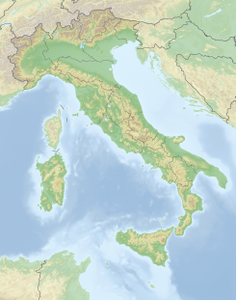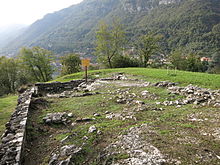Isola Comacina
| Isola Comacina | ||
|---|---|---|
| Isola Comacina | ||
| Waters | Lake Como | |
| Geographical location | 45 ° 57 '53 " N , 9 ° 10' 36" E | |
|
|
||
| length | 500 m | |
| width | 120 m | |
| surface | 7.5 ha | |
| Highest elevation | 239 m slm | |
| Residents | uninhabited | |
The Comacina Island is the only island in Lake Como in the province of Como in Lombardy , Italy . It is opposite the villages of Ossuccio and Sala Comacina . It belongs to the Tremezzina municipality .
Geography and tourism
The island reaches a height of 239 m slm , i. H. 43 meters above the lake level.
The church of San Giovanni is located on the approximately 500 m long and maximum 120 m wide island . In addition, the remains of the Basilica of S. Eufemia , which was destroyed during the war in the 12th century, are preserved on the island . Excavations have brought to light valuable mosaics from Roman times.
On the highest point of the island are the remains of the church of San Pietro in Castello . This is documented in the 12th century and was built over an older fortification.
The island can be reached by boat from Menaggio and a small ferry from Sala Comacina.
Sylvester Stallone , Konrad Adenauer and Kirk Douglas ate in the restaurant on the island .
history
Important is the place for strategic and religious reasons was because the environment in the Great Migration widespread immigrant tribes and the war between Oströmern ( Greeks ) and Lombards broke out. When Uraja brought Milan to surrender in 569 , the rich from Como and the surrounding area fled with their wealth to the small island, which was then still called Cristopolis . Fortifications, houses and churches were built in a short time. The island then gained more and more economic and political importance. In 1118 the 10-year war between Milan and Como began. At that time the island was allied with Milan, which eventually won in 1127. With the three parishes, Dongo , Gravedona and Sorico , Como managed to invade and destroy the island.
In 1175, Emperor Friedrich Barbarossa issued a decree forbidding the reconstruction of churches, fortresses and houses. The island remained uninhabited afterwards, as Bishop Vidulfo pronounced a curse. Then the island was passed on from the diocese to the Vacana family. The owner, Augusto Giuseppe Caprani, decided in 1914 to bequeath the island to Albert I , King of Belgium. In May 1920, Albert I gave the island to the Italian state.
Attractions
- Basilica of Sant'Eufemia
- Church of San Giovanni.
literature
- Ugo Monneret de Villard : L'isola Comacina. Ricerche storiche ed. Archeologiche. In: Rivista Archeologica Comense RAC, Como 1914, pp. 70f.
- Luigi Mario Belloni: L'isola Comacina. Campagna di scavi ottobre 1958 - February 1959. In: Rivista Archeologica Comense RAC, 140, Como 1958
- Idem: L'isola Comacina e la sua antica pieve. Cairoli, Como 1966.
- Idem: L'Isola Comacina dal VI al IX secolo. In: Archivio Storico Lombardo ASL, 1963.
- Matteo Gianoncelli: Note storiche sull'Isola Comacina. in Archivio Storico Lombardo ASL, 1973.
Web links
- Isola Comacina on the ETHorama platform



